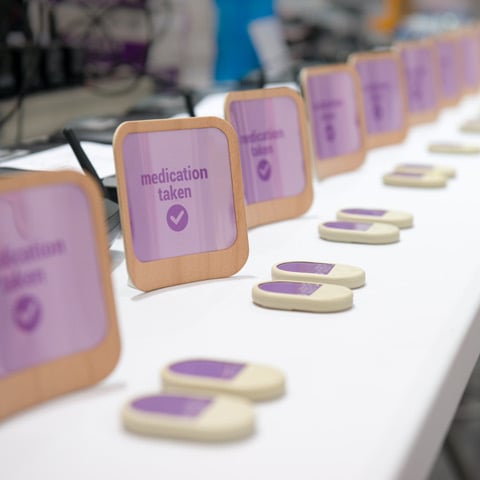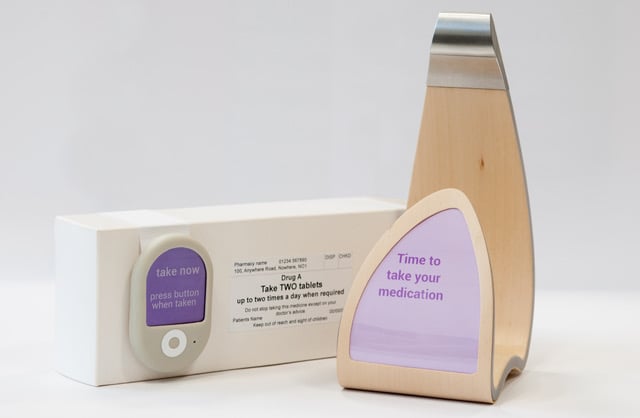New products usually start by identifying a need and gap in the market. Occasionally, some products are so unique they must create their own new market space. Folium Optics, a tech spin out from HP labs in Bristol, had just such a problem. They needed help exploring and visualising how future products might use their low power display film technology to enable them to engage with and inspire new customers.
The journey
Defining a product vision and strategy is an ideal task for design. Folium turned to The Product Partnership (TPP) team to help them explore potential new applications and demonstrate the strengths of their display technology.
One of the early ideas grew into the ‘Totem’ concept. The Totem was a prototype model developed to show off Folium’s display as an Internet of Things (IoT) home display device that connected families with vulnerable family members to ensure their wellbeing.
With the support of an SBRI grant, Totem evolved into My Health Tags, a two-part system consisting of a reusable smart tag that could be fitted to medical packaging to remind users to take their medicine. The Totem unit also enabled remote family and carers to stay in touch and monitor medicine taking. Designability, a Folium Optics partner on the SBRI project, took the lead on the tag design, also working with TPP.
These prototype demonstrators drew on the design, electronics and prototyping expertise of all three TPP partners and proved instrumental in helping Folium Optics demonstrate their technology and secure new customers.

What did TPP do?
The process started with Realise, who analysed the unique strengths and limitations of Folium’s technology. They also carried out future trend research and translated it into potential customer benefits and a wide range of future concept ideas.
A select range of complimentary ideas were developed into an inspiring technology demonstration presentation for Folium to inspire and discuss ideas with potential partners. Following its success, Folium were keen to take the next step and produce a physical demonstrator.
The ‘Totem’ was the result of a brief to connect the elderly and remote loved ones or carers, show off Folium’s low power screen technology and be outside the ‘typically techy’ product architype. They also wanted to open people’s minds to alternative possibilities and uses of the screens. Essentially, they asked Realise to make it look quirky and unusual.
Realise explored a wide range of product ideas. The organic laminated wood design was eventually chosen for its ability to show off Folium’s curved screen without looking like another plastic IoT connected smart home device.
Revising and reiterating the design alongside TPP ensured that the prototype enclosure and electronics would work seamlessly and without issue.
Cubik provided the electronic design review and build for the first and second phases of the My Health Tags programme. This included a prototype batch of 25 units which enabled them to test the manufacturability of the product. As medication is often taken with water, the key challenge for Cubik was making sure the product was entirely waterproof to protect it from any potential spillages and day to day tasks like washing up or cleaning. Following successful completion of the prototype trial, Cubik went on to manufacture, test and ship all units from their in-house production facility.
Amalgam Modelmaking made all the enclosures. The large display Totem concept from Realise was brought to life with three working units and was made by 3D Printing, fine finishing and surface veneer applied by hand. These were then integrated with the electronics and screens to test and ensure everything not only looked but also functioned perfectly.
For the smaller smart tag, Amalgam worked closely with Designability and Folium and suggested improvements to the design. This called for an ABS Surround for the Cubik electronics, a twist-click battery cover and rubber protective cover.
These parts were initially prototyped and refined on the in-house Objet 3D printer. Once the design was finalised, the parts were hand finished to look like production level parts and used as masters to produce multi-cavity silicone moulds. From these moulds, multiple parts could be cast in white Polyurethane ABS and assembled. This gave Folium a batch of 25 prototypes that looked and performed like real products.
Conclusion
- The vivid, always-on, screen displays a notification to let the user know that it is time to take their medication and a touch sensor allows them to confirm when they have taken it.
- The tag is linked to a separate reminder unit that can be placed anywhere in the home to maximise the opportunity of the notification being seen. If the user misses a dose, a warning message is displayed to let them, or a caregiver, know that their medication is overdue. The system also communicates back to remote carers and medical professionals.
- Being able to demonstrate applications of their technology with a suite of visualised ideas and real-world prototypes has enabled Folium Options to develop trust, excitement and, most importantly, new ideas with potential customers. The business has since grown in strength and expanded its product offerings into the food and beverage industry as well as the defence sector.
Client feedback.
“Having the design, mechanical and electronic build teams’ working together locally made a big difference to the spend and quality of the development of the resulting system.”
John Rudin, Co-Founder of Folium Optics
You can find out more about this project on the Folium Optics website.
